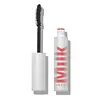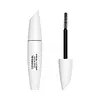What's inside
What's inside
 Key Ingredients
Key Ingredients

 Benefits
Benefits

 Concerns
Concerns

 Ingredients Side-by-side
Ingredients Side-by-side

Water
Skin ConditioningCandelilla Cera
EmollientStearic Acid
CleansingGlycerin
HumectantHydrogenated Olive Oil Stearyl Esters
Emulsion StabilisingPullulan
Helianthus Annuus Seed Wax
Skin ConditioningAcacia Senegal Gum
MaskingAcrylates Copolymer
Copernicia Cerifera Wax
Polyglyceryl-3 Stearate
EmulsifyingRhus Verniciflua Peel Wax
Adansonia Digitata Seed Oil
EmollientPassiflora Edulis Seed Oil
EmollientPCA Glyceryl Oleate
EmollientMangifera Indica Seed Butter
Skin ConditioningZingiber Officinale Water
MaskingCocos Nucifera Oil
MaskingPlumeria Alba Flower Extract
Skin ConditioningPlumeria Rubra Flower Extract
Skin ConditioningCalendula Officinalis Flower Extract
MaskingGardenia Taitensis Flower
Skin ConditioningHydrolyzed Vegetable Protein
Skin ConditioningHydrogenated Vegetable Glycerides
EmollientC18-36 Acid Triglyceride
EmollientTocopherol
AntioxidantSodium Hydroxide
BufferingCellulose
AbsorbentCetearyl Alcohol
EmollientSodium Stearoyl Lactylate
EmulsifyingDipropylene Glycol
HumectantGlyceryl Caprylate
EmollientCaprylyl Glycol
EmollientBenzyl Alcohol
PerfumingSorbic Acid
PreservativeSodium Benzoate
MaskingSodium Dehydroacetate
PreservativePotassium Sorbate
PreservativeCI 77499
Cosmetic ColorantWater, Candelilla Cera, Stearic Acid, Glycerin, Hydrogenated Olive Oil Stearyl Esters, Pullulan, Helianthus Annuus Seed Wax, Acacia Senegal Gum, Acrylates Copolymer, Copernicia Cerifera Wax, Polyglyceryl-3 Stearate, Rhus Verniciflua Peel Wax, Adansonia Digitata Seed Oil, Passiflora Edulis Seed Oil, PCA Glyceryl Oleate, Mangifera Indica Seed Butter, Zingiber Officinale Water, Cocos Nucifera Oil, Plumeria Alba Flower Extract, Plumeria Rubra Flower Extract, Calendula Officinalis Flower Extract, Gardenia Taitensis Flower, Hydrolyzed Vegetable Protein, Hydrogenated Vegetable Glycerides, C18-36 Acid Triglyceride, Tocopherol, Sodium Hydroxide, Cellulose, Cetearyl Alcohol, Sodium Stearoyl Lactylate, Dipropylene Glycol, Glyceryl Caprylate, Caprylyl Glycol, Benzyl Alcohol, Sorbic Acid, Sodium Benzoate, Sodium Dehydroacetate, Potassium Sorbate, CI 77499
Water
Skin ConditioningAcrylates Copolymer
Glyceryl Stearate
EmollientDisteardimonium Hectorite
StabilisingTalc
AbrasiveStearic Acid
CleansingPropylene Glycol
HumectantTriethanolamine
BufferingParaffin
PerfumingBeeswax
Emulsion StabilisingPropylene Carbonate
SolventPolyvinyl Alcohol
Synthetic Wax
AbrasiveEthylhexylglycerin
Skin ConditioningOleic Acid
EmollientAlcohol Denat.
AntimicrobialPhenoxyethanol
PreservativeMicrocrystalline Wax
Emulsion StabilisingBenzyl Alcohol
PerfumingPolyethylene
AbrasiveAscorbyl Palmitate
AntioxidantPanthenol
Skin ConditioningTocopherol
AntioxidantGlycerin
HumectantSodium Laureth Sulfate
CleansingGlycine Soja Oil
EmollientCellulose
AbsorbentTrisodium EDTA
Xanthan Gum
EmulsifyingCocos Nucifera Oil
MaskingPotassium Sorbate
PreservativeMethylparaben
PreservativeArgania Spinosa Kernel Oil
EmollientDimethicone
EmollientRicinus Communis Seed Oil
MaskingSimmondsia Chinensis Seed Oil
EmollientTocopheryl Acetate
AntioxidantPropylparaben
PreservativeAmmonium Hydroxide
BufferingTetrasodium EDTA
Glyceryl Oleate
EmollientBenzoic Acid
MaskingCitric Acid
BufferingMethylcellulose
Emulsion StabilisingSilica Dimethicone Silylate
AbsorbentAloe Barbadensis Leaf Extract
EmollientHippophae Rhamnoides Fruit Juice
Skin ConditioningTrideceth-9
EmulsifyingSorbic Acid
PreservativeBisabolol
MaskingSulfuric Acid
BufferingCI 77891
Cosmetic ColorantWater, Acrylates Copolymer, Glyceryl Stearate, Disteardimonium Hectorite, Talc, Stearic Acid, Propylene Glycol, Triethanolamine, Paraffin, Beeswax, Propylene Carbonate, Polyvinyl Alcohol, Synthetic Wax, Ethylhexylglycerin, Oleic Acid, Alcohol Denat., Phenoxyethanol, Microcrystalline Wax, Benzyl Alcohol, Polyethylene, Ascorbyl Palmitate, Panthenol, Tocopherol, Glycerin, Sodium Laureth Sulfate, Glycine Soja Oil, Cellulose, Trisodium EDTA, Xanthan Gum, Cocos Nucifera Oil, Potassium Sorbate, Methylparaben, Argania Spinosa Kernel Oil, Dimethicone, Ricinus Communis Seed Oil, Simmondsia Chinensis Seed Oil, Tocopheryl Acetate, Propylparaben, Ammonium Hydroxide, Tetrasodium EDTA, Glyceryl Oleate, Benzoic Acid, Citric Acid, Methylcellulose, Silica Dimethicone Silylate, Aloe Barbadensis Leaf Extract, Hippophae Rhamnoides Fruit Juice, Trideceth-9, Sorbic Acid, Bisabolol, Sulfuric Acid, CI 77891
Ingredients Explained
These ingredients are found in both products.
Ingredients higher up in an ingredient list are typically present in a larger amount.
Acrylates Copolymer is used as a film-forming agent and texture enhancer.
After applied, Acrylates Copolymer forms a thin film cover that helps skin feel more soft. It can help sunscreens become more water-resistant.
It is also used to make a product more thick.
Learn more about Acrylates CopolymerBenzyl Alcohol is most commonly used as a preservative. It also has a subtle, sweet smell. Small amounts of Benzyl Alcohol is not irritating and safe to use in skincare products. Most Benzyl Alcohol is derived from fruits such as apricots.
Benzyl Alcohol has both antibacterial and antioxidant properties. These properties help lengthen the shelf life of products. Benzyl Alcohol is a solvent and helps dissolve other ingredients. It can also improve the texture and spreadability.
Alcohol comes in many different forms. Different types of alcohol will have different effects on skin. This ingredient is an astringent alcohol.
Using high concentrations of these alcohols are drying on the skin. They may strip away your skin's natural oils and even damage your skin barrier. Astringent alcohols may also irritate skin.
Other types of astringent alcohols include:
According to the National Rosacea Society based in the US, you should be mindful of products with these alcohols in the top half of ingredients.
Any type of sanitizing product will have high amounts of alcohol to help kill bacteria and viruses.
Learn more about Benzyl AlcoholCellulose is the main component of plant cell walls. It is used as an emulsifier, absorbent, and texture enhancer.
This ingredient has many functions:
Fun fact: Cellulose is the most abundant form of organic polymer on Earth.
Learn more about CelluloseCocos Nucifera Oil is obtained from the kernels of the coconut fruit. In other words, this is coconut oil.
Coconut Oil is rich in fatty acids with lauric acid making up the majority of these. It also contains linoleic acid. Due to this high fatty acid content, coconut oil helps trap moisture and soften skin.
Despite being antibacterial, coconut oil may not be great for acne-prone skin. It is comedogenic and may clog pores. This ingredient may not be safe for malassezia or fungal acne.
Note: Coconut Oil should not replace your sunscreen for UV protection. Studies show it only blocks about 20% of UV.
This oil is non-volatile and has a light scent.
The term 'fragrance' is not regulated in many countries. In many cases, it is up to the brand to define this term. For instance, many brands choose to label themselves as "fragrance-free" because they are not using synthetic fragrances. However, their products may still contain ingredients such as essential oils that are considered a fragrance.
Learn more about Cocos Nucifera OilGlycerin is already naturally found in your skin. It helps moisturize and protect your skin.
A study from 2016 found glycerin to be more effective as a humectant than AHAs and hyaluronic acid.
As a humectant, it helps the skin stay hydrated by pulling moisture to your skin. The low molecular weight of glycerin allows it to pull moisture into the deeper layers of your skin.
Hydrated skin improves your skin barrier; Your skin barrier helps protect against irritants and bacteria.
Glycerin has also been found to have antimicrobial and antiviral properties. Due to these properties, glycerin is often used in wound and burn treatments.
In cosmetics, glycerin is usually derived from plants such as soybean or palm. However, it can also be sourced from animals, such as tallow or animal fat.
This ingredient is organic, colorless, odorless, and non-toxic.
Glycerin is the name for this ingredient in American English. British English uses Glycerol/Glycerine.
Learn more about GlycerinPotassium Sorbate is a preservative used to prevent yeast and mold in products. It is commonly found in both cosmetic and food products.
This ingredient comes from potassium salt derived from sorbic acid. Sorbic acid is a natural antibiotic and effective against fungus.
Both potassium sorbate and sorbic acid can be found in baked goods, cheeses, dried meats, dried fruit, ice cream, pickles, wine, yogurt, and more.
You'll often find this ingredient used with other preservatives.
Learn more about Potassium SorbateSorbic Acid is a preservative. It is the most commonly used food preservative in the world.
Sorbic Acid is a natural antibiotic and highly effective at preventing the growth of fungus. It is less effective against bacteria.
Potassium Sorbate, another commonly-used preservative, is the potassium salt of Sorbic Acid.
Sorbic Acid may worsen eczema. We recommend speaking with a professional if you have any concerns.
Potassium sorbate and sorbic acid can be found in baked goods, cheeses, dried meats, dried fruit, ice cream, pickles, wine, yogurt, and more.
Learn more about Sorbic AcidStearic Acid is a fatty acid. It is an emollient, emulsifier, and texture enhancer.
As an emollient, stearic acid helps soften skin. It aids the skin's protective barrier by preventing water loss. It also provides a gentle cleansing effect without stripping away natural oils.
Stearic acid may also be used to enhance the texture of products. It can add volume and stabilize ingredients such as water and oil. This can help water and oil ingredients from separating.
Sources of stearic acid include animal or vegetable fats/oils such as coconut or shea. It can be naturally found in butter, cocoa butter, shea butter, vegetable fats, and animal tallow.
This ingredient may not be Malassezia folliculitis, or fungal-acne safe.
Learn more about Stearic AcidTocopherol (also known as Vitamin E) is a common antioxidant used to help protect the skin from free-radicals and strengthen the skin barrier. It's also fat soluble - this means our skin is great at absorbing it.
Vitamin E also helps keep your natural skin lipids healthy. Your lipid skin barrier naturally consists of lipids, ceramides, and fatty acids. Vitamin E offers extra protection for your skin’s lipid barrier, keeping your skin healthy and nourished.
Another benefit is a bit of UV protection. Vitamin E helps reduce the damage caused by UVB rays. (It should not replace your sunscreen). Combining it with Vitamin C can decrease sunburned cells and hyperpigmentation after UV exposure.
You might have noticed Vitamin E + C often paired together. This is because it is great at stabilizing Vitamin C. Using the two together helps increase the effectiveness of both ingredients.
There are often claims that Vitamin E can reduce/prevent scarring, but these claims haven't been confirmed by scientific research.
Learn more about TocopherolWater. It's the most common cosmetic ingredient of all. You'll usually see it at the top of ingredient lists, meaning that it makes up the largest part of the product.
So why is it so popular? Water most often acts as a solvent - this means that it helps dissolve other ingredients into the formulation.
You'll also recognize water as that liquid we all need to stay alive. If you see this, drink a glass of water. Stay hydrated!
Learn more about Water